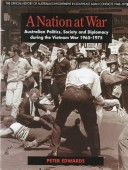OFFICIAL HISTORY OF AUST SE CONFLICT
1 primary work
Book 6
In the late 1960s and the early 1970s, Australia was a nation at war in two senses. After the Menzies Government sent a battalion of troops to the Vietnam War in 1965, the involvement soon became Australia's largest military commitment apart from the two world wars. But in Australia this commitment created bitter divisions in Parliament, churches, universities, unions and families, until supporters and opponents fought in the streets of Australian cities. The Vietnam War, together with the selective form of national service which sent thousands of young conscripts to fight in Vietnam, dominated Australian politics for ten years. This book tells the story of Australia during this tumultuous decade. It shows how the initial support for the Vietnam commitment was eroded until a majority of the population came to think that it was mistaken, if not immoral. The book traces the growth of the protest movement against the War and conscription, giving a detailed account of the three Moratorium protests in which tens of thousands of Australians demonstrated.
The volume discusses the decisions of the Menzies, Holt, Gorton, McMahon and Whitlam Governments, as they responded to these unprecedented protests while wrestling with diplomatic pressures emanating from powerful allies and strife-torn neighbours. The book also analyses the incidents which shaped the debate and which long remained in public memory - the alleged "water torture" incident, the episodes involving conscientious objectors like Simon Townsend and William White, and many more. The book is the sixth volume of the Official History of Australia's Involvement in Southeast Asian Conflicts 1948-1975. Peter Edwards, the Official Historian, has had unrestricted access to official Australian records, including Cabinet papers of both coalition and Labor governments, highly classified documents from the Departments of Defence and Foreign Affairs, and reports of the Australian Security Intelligence Organisation. In addition, he has used a wide range of published and unpublished material, including the papers of organizations and individuals involved in protests and demonstrations, supplemented by personal interviews.
The volume discusses the decisions of the Menzies, Holt, Gorton, McMahon and Whitlam Governments, as they responded to these unprecedented protests while wrestling with diplomatic pressures emanating from powerful allies and strife-torn neighbours. The book also analyses the incidents which shaped the debate and which long remained in public memory - the alleged "water torture" incident, the episodes involving conscientious objectors like Simon Townsend and William White, and many more. The book is the sixth volume of the Official History of Australia's Involvement in Southeast Asian Conflicts 1948-1975. Peter Edwards, the Official Historian, has had unrestricted access to official Australian records, including Cabinet papers of both coalition and Labor governments, highly classified documents from the Departments of Defence and Foreign Affairs, and reports of the Australian Security Intelligence Organisation. In addition, he has used a wide range of published and unpublished material, including the papers of organizations and individuals involved in protests and demonstrations, supplemented by personal interviews.
